
Hydrophtes
Organisms And Their Environment of Class 12
Hydrophtes
They grow on extremely wet soil where water is available to plants in abundance. The aquatic environment remains uniform, the hydrophytes, particularly the submerged and floating forms have less adaptations are chiefly in response to excess water, decreased oxygen supply and low temperatures.
On morpho ecological basis hydrophytes have been divided into five groups :
- FREE FLOATING HYDROPHYTES
- ROOTED HYDROPHYTES WITH FLOATING LEAVES
- SUBMERGED FLOATING HYDROPHYTES
- ROOTED SUBMERGED HYDROPHYTES
- ROOTED EMERGENT HYDROPHYTES
FREE FLOATING HYDROPHYTES
They remain in contact with water and air, but not soil. They float freely on the water surface. Leaves in some are very minute, while in other quite large. Some of the free floating hydrophytes are Wolffia, Lemna, Spirodella, Azolla, Eichhornia, Salvinia and Pistia.
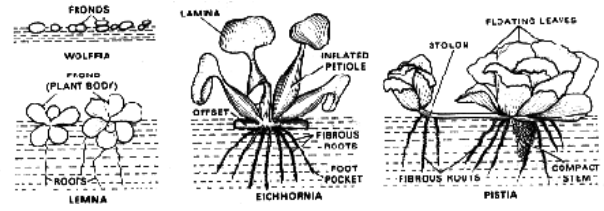
Fig. Free floating plants
Lemna Eichh o rnia Pistia Eicchornia (Water hyacinth) – spongy and swollen petiole, originally belongs to America. Wolffia – rootless smallest Angiosperm. In Lemna (Duck weed) – thalloid plant body, 1-2 balancing roots.
ROOTED HYDROPHYTES WITH FLOATING LEAVES
Their roots are fixed in mud, but leaves have long petioles which keep them floating on the water surface. The remaining plant, except leaves, remains in water. Some of the rooted hydrophytes with floating leaves are Trapa, Nélumbo, Nymphaea and Marsilea, Victoria, Nymphoides.
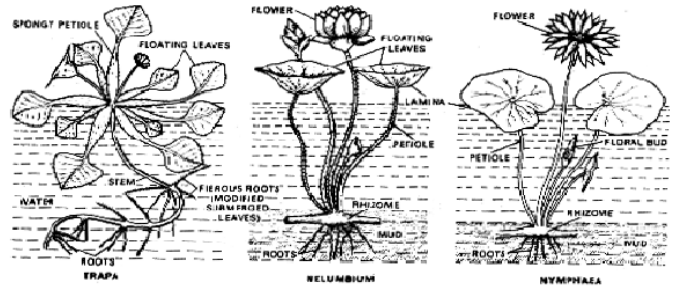
Fig. : Rooted hydrophytes with floating leaves
SUBMERGED FLOATING HYDROPHYTES
These are also called suspended Hydrophytes. These are the plants in contact with only water, being completely submerged and not rooted in the mud. Their stems are long and leaves generally small. Some of the examples are Ceratophyllum, Utricularia, Najas, etc. In Ceratophyllum, roots are lacking even in embryo stage, sometimes leafy branches are modified into rhizoids.
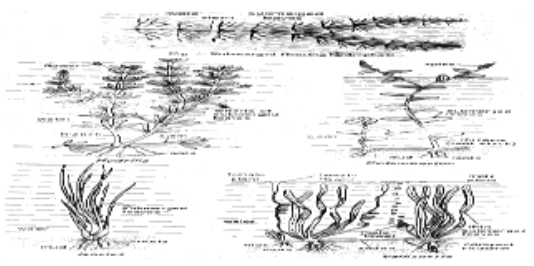
Fig. Submerged floating hydrophytes
ROOTED SUBMERGED HYDROPHYTES
These are hydrophytes like Hydrilla, Potamogeton, Isoetes and Vallisneria , which remain completely submerged in water and rooted in soil. In Hydrilla, Potamogeton and Chara , the stem is long, bearing small leaves at the nodes. Hydrilla is a slender weed with fibrous roots. In Isoetes and Vallisneria stem is tuberous (corm like) with long leaves, which are narrow, ribbon shaped.

Fig. : Rooted submerged hydrophytes
ROOTED EMERGENT HYDROPHYTES
These are also called amphibious plants. They grow in shallow waters along the margin of pond/lake. e.g. Ranunculus, Sagittaria, Monochoria Typha, Cyperus these are such hydrophilus forms which, although require excess of water, but their shoots (assimilatory organ) are partly or completely exposed to air. The root system is completely under water, fixed in soil. in some, as Sagittaria and Ranunculus, shoots are partly in water and partly emerging i.e., exposed to air, whereas in others such as Scirpus and Cyperus also known as marshy plants, the shoots are completely exposed to air.
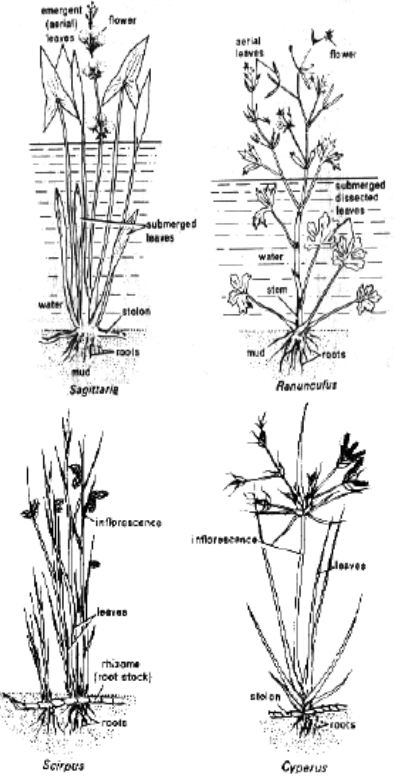
Fig. : Rooted emergent hydrophytes
CHARACTERISTICS OF HYDROPHYTES
Hydrophytes may differ from each other in some aspects, but most of the characteristics morphological as well as anatomical, are common to all of them. Due to these similarities, they belong to the same ecological group; the hydrophytes.
Morphological Features
Roots
In Salvinia submerged leaves compensate for roots. However, in emergent forms as Ranunculus which grow in mud, roots are well developed with distinct root caps. Root hairs are absent or poorly developed. Root caps are usually absent. In some cases, as in Eichhornia, root caps are replaced by root pockets.Roots, if present, are generally fibrous; adventitious, reduced in length, unbranched or poorly branched. In Lemna, roots act simply as balancing and anchoring organs. In some plants as Jussiaea repens, there develop some floating aerial roots also in addition to normal adventitious roots.
Stem
In submerged forms as Hydrilla and Potamogeton, stem is long, slender, spongy and flexible. In free floating forms it may be slender, floating horizontally on water surface as in Azolla or thick, short, stoloniferous and spongy as in Eichhornia. In forms which are rooted with floating leaves, it is a rhizome as in Nymphaea and Nelumbo. Vegetative propagation by runners, stolons, stem and root tubers, dormant apices, offsets etc., is the most extensive and common method of reproduction. Thus most of them are perennials.
Leaves
In submerged forms, leaves are thin, and are either long and ribbon shaped as in Vallisneria, or long and linear as in Potamogeton, or finely dissected as in Ceratophyllum. Floating leaves are large, flat and entire as in Nymphaea and Nelumbo with their upper surface coated with wax. Their petioles are long, flexible and often covered with mucilage, in Eichhornia and Trapa petioles become swollen and spongy. Emergent forms as Ranunculus and Sagittaria show heterophylly with submerged, floating, and aerial leaves. Emergent leaves are generally translucent.
Flowers and Seeds
These are less common in submerged forms. Where flowers develop seeds, are rarely formed.
Anatomical Features
Root
The distribution of various tissues in roots of hydrophytes, in general, becomes clear from figure showing transverse sections of roots.
It may be concluded from these figures that :
- Cuticle is either completely absent, or if present, it is thin and poorly developed.
- Epidermis is usually single layered made up of thin walled parenchymatous cells.
- Cortex is well developed, thin walled and parenchymatous, major portion of which is occupied by well developed prominent air cavities, the aerenchyma, which offers resistance to bending stress, increases buoyancy and allows a rapid gaseous exchange.
- Vascular tissues are poorly developed and least differentiated in submerged forms, as in Potamogeton with thin walled elements. In xylem, vessels are less common, trachieds being generally present. In floating forms as in Eichhornia they are comparatively differentiated to some extent. However, in emergent forms as Ranunculus and Typha etc. vascular elements are comparatively much distinct and well developed.
- Mechanical tissues are generally absent except in some emergent forms, as Typha where pith cell are sclerenchymatous.
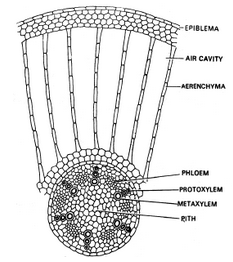
Fig. : T.S. roots of Eichhornia
Stem
Distribution of various tissues in stems of hydrophytes becomes clear form transverse section of stem of Hydrilla. It may be seen that Cuticle is either absent or poorly developed and thin. Epidermis is usually single layered made up of thin walled parenchymatous cells. However, rhizomes of Nymphaea and Nelumbo show well developed epidermis. In emergent forms as Typha, cuticles as well as epidermis are generally well developed.
Hypodermis is completely absent in submerged forms as Hydrilla and Potamogeton. However, in floating and emergent forms, it may be present as thin walled parenchyma or collenchyma.
Cortex is well developed, thin walled and parenchymatous, extensively traversed by air cavities as seen in roots. Cells of cortex generally possess chloroplasts and are thus photosynthetic. In some cases, as Nymphaea, there are found large number of vascular bundles scattered in the cortex.
Endodermis is generally distinct, especially in rhizomes and similar organs.
Vascular bundles generally lack bundle sheaths. Vascular elements are thin walled, lignified elements being absent. However, in emergent forms as Typha, vascular elements are comparatively well differentiated and developed. Mechanical tissues are usually absent.
Leaves
In their internal structure, leaves in different hydrophytes show variations. However, some of the anatomical features are common to most of the leaves. Distribution of different tissues in leaves of hydrophytes would become clear from vertical transverse sections of leaves of Anacharis, Potamogéton and Nymphaea respectively. From these we may conclude that in leaves, Cuticle is usually absent in submerged form as Anacharis and Potamogeton. In floating forms as Nymphaea it is poorly developed confined only to upper side and is thin. In emergent forms also it is thin.
Epidermis is single layered, made up of thin walled cells with abundance of chloroplasts.Stomata are completely absent in submerged leaves as Anacharis and Potamogeton. In floating forms as Nymphaea, stomata are confined only to the upper surface of leaf, whereas in emergent forms they are generally found on both surface of leaves.
Mesophyll is undifferentiated in submerged leaves, where it is generally single layered as in Potamogeton. In Anacharis also it is thin and undifferentiated. In floating leaves as in Nymphaea, it is, however, differentiated into palisade and spongy parenchyma with well developed air cavities. In emergent leaves, mesophyll is well differentiated with air cavities.
Vascular tissues are very much reduced and sometimes difficult to be differentiated into xylem and phloem as in leaves of submerged forms like Anacharis. Wherever differentiated as in Nymphaea, xylem elements are thin walled, phloem being well developed. However, in aerial leaves, vascular elements are comparatively well differentiated with vessels in xylem.
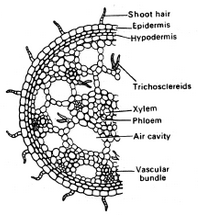
Fig. : Part of petiole of Nymphaea
Mechanical tissues are absent. The petioles, wherever well developed, as in Nymphaea, also possess internally the various tissues characteristics of a typical hydrophyte, i.e., an abundanceof aerenchyma, thin walled cells, lack of differentiation in vascular tissues and absence of any lignified mechanical tissue. We have described in detail the various morphological and anatomical features of each of the three major ecological groups of plants i.e., hydrophytes, mesophytes and xerophytes.
To sum up this detailed descriptive account of various features for the purpose of quick revision, the same has been presented in a comparative way in the table.
| Hydrophytes | Mesophytes | Xerophytes |
| Morphological | ||
|
Excepting the emergent form,
roots are generally greatly reduced, even absent; if present, unbranched without root hairs. |
Root system well developed tap
or fibrous roots with root hairs. |
Root system is generally very deep,
extensive, reaching deeper layers of soil, several times larger than shoot, hard, woody. |
|
Stem is very much reduced,
in some plants modified into rhizomes, thin, delicate. |
Stem is rigid and stout. |
Stem much dwarfed, branched,
sometimes underground |
|
Leave thin, narrow, linear,
some with long petioles and large lamina, covered with wax or hairs, in some dissected into segments, |
Leaves, large, thin, generally
without waxy surface. |
Leave small, sometimes much reduced to
scales or modified into spines in some leathery and thick with shining surface and waxy coating, covered with hairs. |
| Anatomical | ||
|
Aerenchyma is extensive in almost
all vegetative organs. |
Aerenchyma is lacking. | Aerenchyma is lacking. |
| Cuticles are generally absent. | Cuticles developed. | Cuticle thick, well developed. |
|
Stomata either absent, or if present,
only at upper surface or even non-functional. |
Stomata on one or both the surfaces. |
Stomata less in number, generally confined
to the lower surface of leaves, sunken. |
|
Mesophyll undifferentiated into palisade
into palisade and spongy parenchyma. |
Palisade is well developed, differentiated. |
Palisade is generally on both sides of leaves,
cells and vacuoles. |
|
Chlorophyll is present in addition to leaves,
also in other parts of plant. |
Chlorophyll mostly in leaves. | Chlorophyll mostly in stems and leaves. |
| Epidermal cells are thin walled. | Epidermal cells are thick walled. | Epidermal cells are conspicuously thick walled. |
|
Lignified mechanical tissues lacking,
conducting elements very few, non-lignified. |
Mechanical and vascular tissues well developed. |
Mechanical and vascular tissues are
very well developed. |
| Physiology | ||
|
Habitats mostly deficient in oxygen content,
thus having an ability to respire anaerobically, or have low oxygen requirement. Special aerating organs are present. |
Normal physiological process, with temporary
wilting at room temperature. |
Most of the features to reduce the transpiration rates,
ephemerals complete their life cycle in a short period. High osmotic pressure (as much as 3100 atms. In some halophytes), and endurance of desiccation. |
PLANTS ADAPTATIONS TO SALINE ENVIRONMENTS – HALOPHYTES
They are special type of xerophilous plants which grow on saline soils with high concentration of salts like NaCl, MgC12 and MgSO4. Soils are physiologically dry. Their osmotic pressure values are very high. Most of them are succulents; their leaves are evergreen, thin, small and leathery with water storage tissues, thick cuticle and well developed palisade tissue. Most of them produce special type of branched, negatively geotropic roots that come out of the mud surface to encourage the entry of oxygen gas. These roots are called pneumatophores which possess breathing pores for gaseous exchange. Some of the halophytes show vivipary i.e., germination of seeds before they are shed from parent plant. The universal feature of these plants is selective absorption and tolerance of sodium chloride, and the ability to grow in soils so saline that they are either physiologically toxic to normal plants or impose so serious an osmotic water stress that water absorption is impeded. Plant cells are bathed in a medium of high osmotic potential and thus should maintain a higher vacuole osmotic potential in order to avoid loss of water.
Halophytic communities have been divided (Warming, 1909) into:
- Lithophilous : Growing on rocks and stones.
- Psammophilous : Growing on sand.
- Pelophilous : Growing on mud.
- Helophilous : Growing on swamp.
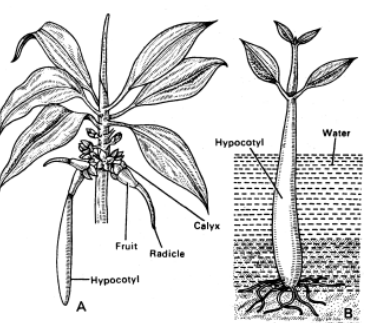
Fig. : A. Vivipary, B. A young plant
Helophilous halophytes have been further sub divided into:
- Salt swamp and salt desert
- Littoral swamp forest (mangrove)
Littoral swamp forests (mangroves) are most extensive, which occur in all tropical seas, especially on flat, muddy shores, where the water is relatively cairn, as in lagoons, inlets, estuaries etc. Soil is flooded with water either permanently or at high tide. These littoral swamp forests form characteristic vegetation, known as the mangroves or mangrove formations in tropical and subtropical areas. e.g. Sonneratia, Rhizophora, Avicennia.
In India, mangroves are very much prevalent on seashores of Bombay and Kerala and in Andaman and Nicobar islands. They grow on water lodged soil, where habitat is characterized by sandy, swampy and saline soils, high precipitation, high atmospheric humidity and almost no fluctuation in temperature throughout the year. The two common halophytes of this type are Rhizophora mucronata and Sonneratia. They produce stilt roots, pneumatophores, and show vivipary.
PLANTS ADAPTATIONS TO OLIGOTROPHIC SOILS
Oligotrophic soils are poor in nutrients. One such type of soil which supports dense vegetation is the one found in tropical rain forests. Here the top soil is shallow while subsoil has dense clay mixed with iron – aluminium compounds. Despite growing in oligotrophic soil, nutrient accumulation is high in vegetation. More than 84% of nutrients undergo biogeochemical circulation. A major adaptation of tropical plants is the presence of mycorrhizae. Mycorrhiza is a mutualistic association of plant roots with fungi. It is useful in retrieval of critical elements from organic compounds ( e.g. , phosphorus), absorption of water and protection from soil borne pathogenic fungi.
Mycorrhiza is of two types :
- Endomycorrhiza : Fungus sends hyphal ends into cortical cells as vesicles and arbuscules (branched masses). Therefore, also called vesicular – arbuscular mycorrhiza or VAM. Intercellular hyphae and external hyphae are present but fewer, e.g. , Herbaceous angiosperms (orchids, grasses) tropical trees.
- Ectomycorrhiza : The fungus forms a mantle on outside and intercellular hyphae in cortex of root. Host secretes nutrients in intercellular spaces. Ectomycorrhizae occur in several trees and shrubs of temperate areas and some tropical species as well, e.g. , Pine, Oak, Eucalyptus.
ADAPTATIONS OR STRATEGIES OF ADAPTATIONS IN ANIMALS
Like plants, animals also adjust to different environmental conditions to survive and flourish. Animals have adaptations to Particular feeding habit like carnivory and herbivory. Protection from predators. Camouflage for easy predation.Structural and behavioural adaptation to attract mate, e.g. , bright plumage of male birds. Physiological and behavioural adaptation to environmental variations and stress conditions, e.g. , migration, hibernation, aestivation, camouflage, mimicry, echolocation, water scarcity, prevention of freezing.
Some of these adaptations are described below :
-
Migration
The movement of animals carried out regularly often between breeding place and winter feeding grounds.
Migration is of three types –
- daily
- seasonal
- cyclic
The distance may be short or long. The longest distance travelled by an animal is that of sea bird arctic Tern (Sterna parasissaea). It nests in North Pole during summer but flies to Antarctica autumn to return to North Pole during spring. The distance travelled is 17,600 km. Golden Plover (Pluvialis dominica) is a winter visitor in India. It flies nonstop for 3600 km and uses only 2 ounces of high octane fuel. Birds use position of sun, moon, stars and magnetic field for direction and navigation. Caribou, Elk and Whales migrate during winter to warmer places for search of food. In Africa, wild beasts travel long distances along the geographical pattern of seasonal rainfall and hence availability of fresh vegetation. Periodic migration occurs in locusts when their number increases beyond the feeding capacity of the homeland. Large populations migrate in search of food to various directions. Sea Lamprey (Petromyzon marinus) migrates from sea to ascend rivers for spawning (anadromous). On the other hand Eel (Anguilla bengalensis)
| Type of migration | Examples | Activities |
| Long- distance | Arctic tern |
Nests close to the north pole in summer;
flies south to Antarctica in autumn; returns to the north pole again each spring. |
| Short-distance | Many birds |
Birds migrate by using the sun, moon, stars
or magnetic field for direction and navigation. |
| Caribou, elk and whales | Migrate in search of food each winter to warmer places | |
| Periodic | Locust | Large populations migrate in search of feeding grounds. |
Fig. : Migration as a Strategy of Adaptation of Animals
- Camouflage (Cryptic Appearance) It is the ability to blend with the surroundings or background. It is the most common type of adaptation by animals to remain unnoticed for protection or aggression, e.g. , many insects, reptiles and mammals. It is difficult to distinguish leaf like grasshopper (Arantia rectifolia) or Praying Mantis (Mantis religiosa) from the surrounding foliage.
- Hibernation and Aestivation Hibernation or winter sleep and aestivation or summer sleep are quite common in ectothermal (cold blooded) animals. They, however, also occur in those warm blooded or endothermal animals which do not migrate from area of intense cold or heat.
- Aestivation Spending the dry-hot period in an inactive state. Frog, an ectothermal animal, shows both hibernation and aestivation. Northern Ground Squirrels, endothermal mammals, undergo hibernation during winter in comparatively warm places. During hibernation their body temperature drops but remains above the outside atmosphere. Breathing and heart beat become slow to reduce consumption of stored food. Endothermal Ground Squirrels of South-Western deserts undergo aestivation and lie in torpid or listless state inside the burrows during hot dry periods.
- Mimicry It is resemblance of one species with another in order to obtain advantage, especially, against predation. The species which is imitated is called model while the animal which imitates is known as mimic or mimictic.
Mimicry is of two types
- Batesian
- Mullerian
Batesian Mimicry : The mimic is defenseless. It has, however resemblance to a dangerous or unpalatable model so that the predator usually does not prey upon it, e.g. , Viceroy Butterfly mimics unpalatable and toxic Monarch Butterfly.
Mullerian Mimicry : It is resemblance to two animal species, especially insects, both unpalatable/ferocious, to their mutual benefit, e.g. , Monarch Butterfly and Queen Butterfly.
- Warning Colouration Dart frogs (Phyllobates bicolor, Dendrobates pumilio) found in tropical rain forests of South America are highly poisonous as well as brightly coloured to be easily noticed. Predators usually avoid them.
- Echolocation Bats are noctural flying mammals which do not employ eyesight for location of their path, food, place of rest, etc. They produce high frequency sound which produces echoes after striking various objects on the principle of sonar. Echoes are analysed by the bats to know their path.
- Adaptations to Water Scarcity Two types of adaptations are prominent in animals living in arid regions, like lowering of water loss as much as possible and adapting to arid conditions. e.g. , Kangaroo rat, Camels etc. The Kangaroo rat conserves water by excreting solid urine and live from birth to death even without drinking water. Camels show unique adjustments to desert conditions being very economical in water use, tolerant to wide fluctuations in body temperature and are able to maintain blood stream, moisture even during extreme heat stress.
- Adaptations to Excessive Cold (Cold Hardening) Sea animals cannot undergo hibernation. Sessile animals cannot migrate. These and some other animals protect themselves from excessive cold by developing cold hardiness, e.g. , barnacles and molluscs of intertidal zones of cold areas, several insects and spiders. Cold hardiness is achieved by developing extra solutes in the body fluids and special ice nucleating proteins in the extracellular spaces. The extra solutes which prevent freezing are glycerol and antifreeze proteins. They lower the freezing point of body fluids. Ice Fish (Chaenocephalus) or Antarctic Fish (Trematomus) remains active even in extremely cold sea water due to this hardiness.
| Type | Examples | Processes and Activities |
| Hibernation | Northern ground squirrels |
True hibernators go into sleep during winter;
body temperature drops; breathing and heart beat become slow. |
| Aestivation | Ground squirrels in south-west deserts |
Avoid heat by spending a dry-hot
period in a torpid state into burrows. |
| Cryptic appearance (camouflage) |
Leaf-like grasshopper (Arantia rectifolia)
Praying mantis (Phyllocrania paradoxa) |
Grasshopper resembles the complete leaf or appears
to be a part of the leaf. Mimics a dead leaf and resembles background vegetation. |
| Batesian mimicry | Monarch butterfly and the mimic viceroy butterfly |
Monarch butterfly (contains toxins in the body)
and mimicked by viceroy butterfly (contains no toxins.) |
| Mullerian mimicry |
Monarch butterfly and the mimic
queen butterfly |
Both butterfly species look similar and
are also distasteful. |
| Echolocation | Horseshoe bat |
Produce high frequency sounds; detects the presence
of the echoes produced from the objects on the same principle of sonar. |
Table : Behavioural Strategies of Adaptations in Animals






